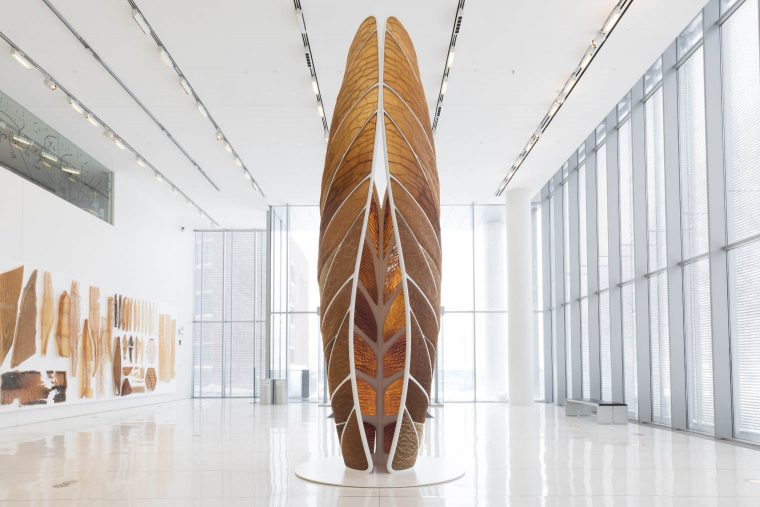
Famous designer Neri Oxman has renewed her collaboration with Stratasys. Known for its complex 3D printed art creations, Oxman harnesses 3D printing again within two projects. This time, the artist achieves two new projects with the help of Stratasys and The Mediated Matter Group: Aguahoja and Totem.
Aguahoja
Made in commemoration of the UN’s recent World Water Day, Aquahoja is a collection of artefacts (Aguahoja I and the forthcoming Aguahoja II) made out of organic matter and shaped by water.
The first Aguahoja was conceived in commemoration of the UN’s recent World Water Day.
The works aim to subvert this cycle through the creation of biopolymer composites that exhibit tuneable physical and environmental properties in ways that are impossible to achieve with their synthetic counterparts.
Aguahoja I includes three artefacts, the central piece of which is an ‘architectural pavilion,’ a 5m-long spinal structure comprising 95 individual 3D printed segments. The team of Stratasys Direct Manufacturing (SDM) used the company’s F900 3D Printer to manufacture the pavilion’s large-scale and complex geometry.
However, assembling such a tall and complicated structure presented a challenge – as a result a series of custom fixtures were printed to hold each individual component together. Chosen for its superior mechanical properties and aesthetic appearance, the robust ASA material provides the necessary rigidity to keep the entire structure stable, while also housing organic matter.
Totem
The second project, Totem, has been achieved with a goal similar to the mask collection Vespers: address and speculate upon designers’ ability to chemically synthesize the ‘pigment of life,’ melanin
The work of art features a demonstration of melanin production on an architectural scale for deployment in specific environmental contexts. Included in the project is an architectural proposal for an environmentally responsive melanin-infused glass-like structure.
As part of this project, the channels in the glass structure within which the melanin is housed, were 3D printed using a transparent digital material from Stratasys. Once the entire model was 3D printed, the liquid support material was washed away leaving finely-detailed hollow structures to house melanin – a first-of-its kind in 3D printing and the only way that this design could have been produced.
“One of the key criteria for Totem was the need to securely contain the melanogenic structure without compromising the ability to flawlessly promote every level of visual detail. As a result, we used an advanced transparent 3D printing material that can simulate the clarity of glass, enabling a clear visualization of the internal components and features,” explains Neri Oxman.
You can now post free of charge job opportunities in the AM Industry on 3D ADEPT Media.
For further information about 3D Printing, follow us on our social networks and subscribe to our newsletter!
Would you like to be featured in the next issue of our digital magazine? Send us an email at contact@3dadept.com





